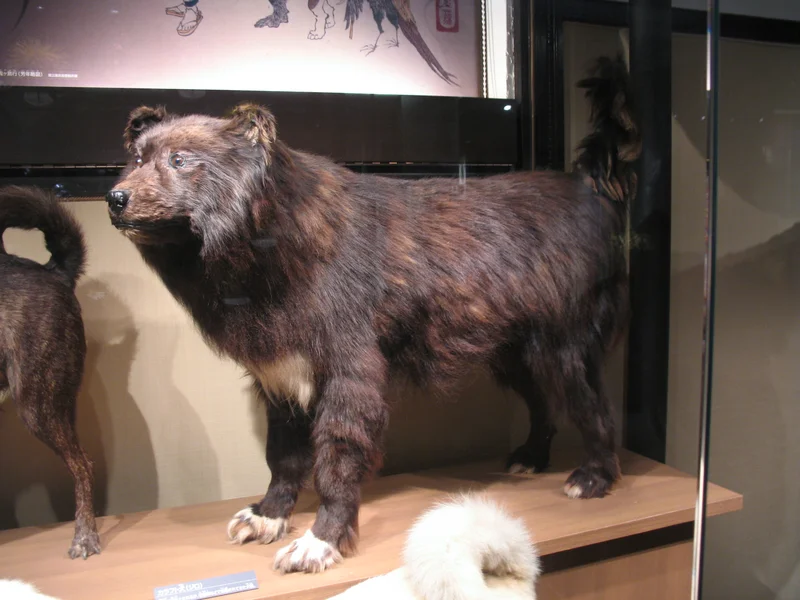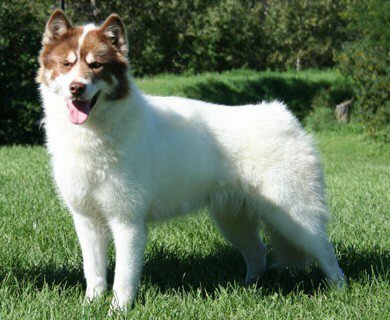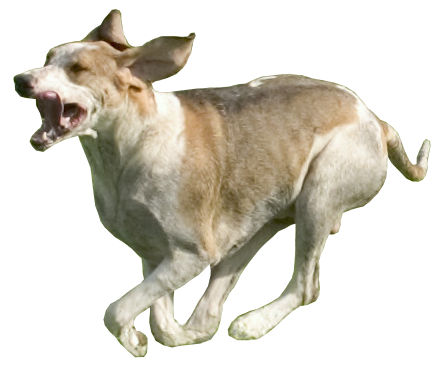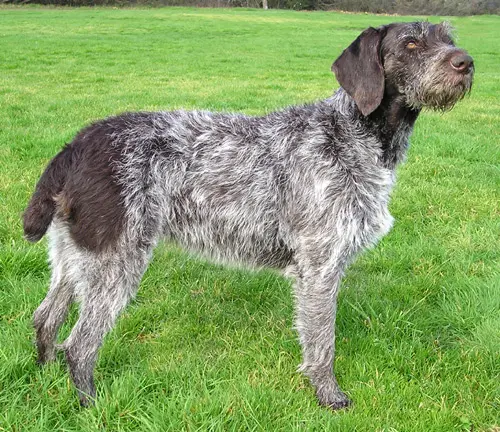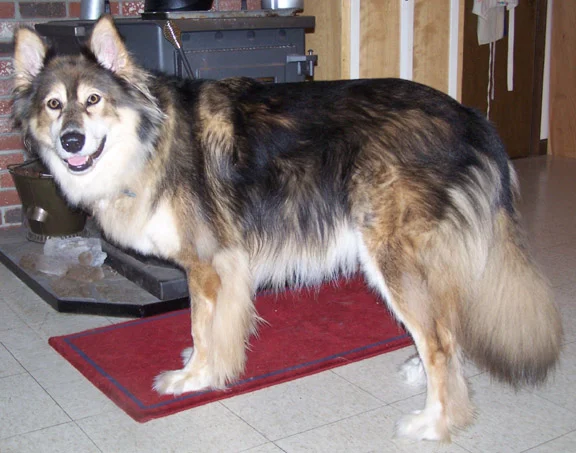Volkosob
The Volkosob, or Wolfdog, is a striking breed known for its loyalty, intelligence, and strong work ethic. With a wolf-like appearance, this breed requires experienced owners who can provide ample exercise and training.
Overview
🐕Breed Overview
✨Key Traits
💡What Makes Volkosob Special
One of the standout traits of the Volkosob is its remarkable intelligence, which allows it to learn commands and tasks quickly. This breed is also known for its strong work ethic, often excelling in activities that require focus and determination.
Their loyalty is unparalleled, as they are fiercely devoted to their families and will go to great lengths to protect them. Additionally, Volkosobs possess a natural curiosity and a strong prey drive, which can lead to interesting behaviors during playtime.
These key traits make them well-suited for active families who can provide the necessary exercise and mental stimulation.
The Volkosob, often referred to as the Wolfdog, is a striking breed that combines the loyalty of domestic dogs with the wild spirit of wolves. Originating from Eastern Europe, this breed has a rich history rooted in the desire to create a versatile working dog capable of thriving in harsh environments. With its wolf-like appearance, the Volkosob captures the attention of dog enthusiasts and nature lovers alike.
Known for its intelligence, strength, and independence, this breed requires an experienced owner who can provide firm leadership and consistent training. In terms of personality, Volkosobs are known for their loyalty and protective instincts. They form strong bonds with their families and are often wary of strangers, making them excellent guardians.
However, their independent nature can lead to stubbornness, requiring dedicated training and socialization from an early age. These dogs thrive in active households where they can participate in outdoor activities, such as hiking, running, and playing fetch. Their high energy levels demand regular exercise, ideally 90 to 120 minutes a day, to keep them physically and mentally stimulated.
Volkosobs are also known for their unique vocalizations, often communicating through a range of sounds, including barking, howling, and even yodeling. Their noise level can vary depending on their mood and environment, making it essential for owners to understand their communication style. In terms of care, the Volkosob's grooming needs are moderate, requiring regular brushing to manage shedding and maintain coat health.
Their diet should be high-quality and tailored to their activity level, with a focus on protein-rich foods to support their energy needs. Overall, the Volkosob is a remarkable breed that requires an experienced owner who can provide the necessary training, socialization, and exercise to ensure a happy and healthy life. For those willing to invest the time and effort, the Volkosob can be a loyal and loving companion, embodying the spirit of the wild while thriving in a family environment.
🎉Fun Facts
They are often described as having a 'wolf-like' demeanor, exhibiting both playful and serious traits depending on the situation.
This breed has a strong prey drive, which can lead to interesting behaviors, such as chasing after small animals or toys.
Volkosobs are highly trainable but require consistent leadership and mental stimulation to thrive.
Volkosobs are known for their striking resemblance to wolves, making them a popular choice for those who admire wild canines.
Breed Characteristics
Family & Friends
Good Behavior
Get Up & Go
Household Harmony
Temperament & Personality
✨Key Traits
🐕Core Temperament
The Volkosob's temperament is characterized by loyalty, intelligence, and a protective nature. They are known to be affectionate with their families, often forming strong bonds with children and other pets.
However, their independent streak can lead to challenges in training, as they may exhibit stubbornness if not properly motivated. Socialization from an early age is crucial to ensure they are well-adjusted and comfortable in various environments.
While they can be wary of strangers, their loyalty to their families makes them excellent watchdogs. Overall, the Volkosob's temperament requires an experienced owner who can provide consistent training and socialization.
💫Personality Profile
The Volkosob is a breed that embodies loyalty and intelligence, often forming deep bonds with its human companions. They are known for their protective nature, making them excellent guardians of their families and homes.
While they can be reserved around strangers, their affectionate side shines through with those they trust. Volkosobs are energetic and require regular physical activity to keep them happy and healthy.
Their independent spirit can sometimes lead to stubbornness, requiring owners to be patient and consistent in training. Overall, they thrive in active households where they can engage in various activities and receive plenty of attention.
🔊Vocal Tendencies
Volkosobs have a moderate noise level, with a tendency to bark, howl, and vocalize in various situations. They may bark to alert their owners of strangers or unusual sounds, but they are not excessive barkers.
Their vocalizations can vary based on their mood; for instance, they may howl when excited or anxious. Understanding their vocal communication is essential for owners, as it can provide insights into their emotions and needs.
While they may not be the quietest breed, their vocalizations are typically manageable with proper training and socialization.
Affection & Social Traits
Energy & Activity
Communication Style
Care Requirements
🏃♂️Exercise Requirements
Daily Exercise
The Volkosob, a breed known for its high energy levels and strong work ethic, requires a significant amount of daily exercise to maintain its physical and mental well-being. Ideally, an adult Volkosob should engage in at least 90 to 120 minutes of exercise each day. This exercise should be divided into multiple sessions to keep the dog stimulated and prevent boredom.
Activities can include brisk walks, running, hiking, swimming, and engaging in dog sports such as agility or obedience training. Puppies may require shorter, more frequent play sessions to accommodate their developing bodies, while senior dogs may benefit from gentler activities to avoid strain. Regular exercise not only helps manage weight but also promotes cardiovascular health, reduces behavioral issues, and enhances overall happiness.
Insufficient exercise can lead to destructive behaviors, anxiety, and obesity, making it crucial for owners to prioritize their Volkosob's activity needs.
Preferred Activities
🏠Living & Adaptability
Space Requirements
Volkosobs thrive in environments that provide ample space for them to roam and play. They are best suited for homes with large yards or access to open areas where they can run freely.
While they can adapt to apartment living if given sufficient exercise, it is not ideal due to their high energy levels. Owners in smaller living spaces should ensure they have access to parks or open fields for daily exercise.
The breed's size and activity level mean that confinement in small spaces can lead to frustration and destructive behaviors. Therefore, providing a stimulating environment with plenty of room to explore is essential for their well-being.
Climate Preference
🍲Feeding Guide
Schedule
Food Types
Portion Size
Special Nutritional Needs
Volkosobs may have specific dietary needs due to their active lifestyle. A high-protein diet is essential to support their energy levels and muscle maintenance.
Owners should be cautious of food sensitivities and may need to avoid common allergens such as grains or certain proteins. Supplements such as omega fatty acids can help maintain coat health and joint function, especially in older dogs.
✨Grooming Requirements
Grooming Overview
The Volkosob has a thick double coat that requires regular grooming to keep it healthy and free from mats. During shedding seasons, typically in spring and fall, daily brushing is recommended to manage loose hair and prevent tangles.
Use a slicker brush and an undercoat rake to effectively remove dead hair. Bathing should be done as needed, usually every few months, to maintain coat cleanliness without stripping natural oils.
Regular nail trimming and dental care are also essential to ensure overall health. Pay attention to the ears, cleaning them regularly to prevent infections, especially in active dogs that may encounter dirt and moisture.
Care Schedule
Brush 2-3 times a week; bathe every 2-3 months; trim nails every 2-4 weeks.
Health Profile
⚕️Health Care
Regular health care is vital for the Volkosob's lifespan. Routine veterinary check-ups, vaccinations, and preventive treatments are essential to catch any health issues early.
Regular dental care, parasite prevention, and monitoring for any changes in behavior or health can significantly impact their overall well-being. Owners should also be proactive in managing their dog's weight and exercise levels, as obesity can lead to various health problems and shorten lifespan.
Establishing a consistent health care routine is key to promoting a long and healthy life for the Volkosob.
Health Issues Overview
⏳Average Lifespan
Genetic Factors
Genetics play a crucial role in the Volkosob's lifespan, with certain hereditary health issues being more prevalent in the breed. Responsible breeding practices that prioritize genetic diversity can help reduce the risk of inherited conditions.
Potential owners should seek reputable breeders who conduct health testing and provide transparency about the lineage of their dogs. Understanding the genetic predispositions of the breed can help owners make informed decisions and take proactive measures to ensure their dog's health and longevity.
Living Conditions
The Volkosob's lifespan can be influenced by various environmental factors. Dogs living in active households with ample exercise and mental stimulation tend to live longer, healthier lives.
Access to outdoor spaces for exercise, a balanced diet, and regular veterinary care significantly contribute to their longevity. Additionally, a stable and loving home environment reduces stress and anxiety, promoting overall well-being.
Exposure to harsh climates or neglect in care can adversely affect their health and lifespan, making it essential for owners to provide a nurturing environment.
🏥Common Health Issues
Hip Dysplasia
Warning Signs
🔬Diagnosis
Veterinarians typically diagnose hip dysplasia through physical examinations and X-rays.
💊Treatment
Treatment options may include weight management, physical therapy, or surgery in severe cases.
📝Management Tips
Maintain a healthy weight, provide joint supplements, and engage in low-impact exercises to reduce strain on the hips.
Elbow Dysplasia
Warning Signs
🔬Diagnosis
Diagnosis is made through physical exams and imaging techniques such as X-rays or CT scans.
💊Treatment
Treatment may involve pain management, physical therapy, or surgical intervention.
📝Management Tips
Provide a balanced diet, regular exercise, and avoid excessive jumping or running on hard surfaces.
Progressive Retinal Atrophy (PRA)
Warning Signs
🔬Diagnosis
Diagnosis is typically made through veterinary eye examinations and genetic testing.
💊Treatment
Currently, there is no cure, but management focuses on providing a safe environment.
📝Management Tips
Regular veterinary check-ups and monitoring for changes in vision.
🛡️Preventive Care
🔬Hip Evaluation
Hip Evaluation assesses the hip joints for signs of dysplasia and other abnormalities, which is crucial for this breed due to its predisposition to hip issues.
📅 Annually after 12 months of age.
🔬Elbow Evaluation
Elbow Evaluation checks for elbow dysplasia and other joint issues, important for maintaining mobility and quality of life.
📅 Annually after 12 months of age.
🔬Eye Examination
Eye Examination screens for hereditary eye conditions such as Progressive Retinal Atrophy, which can affect vision in this breed.
📅 Every 1-2 years, or as recommended by a veterinarian.
Training
🧠Intelligence & Trainability
💪Work Drive
The Volkosob has a strong work drive, stemming from its wolf ancestry. This breed requires mental and physical stimulation to stay happy and healthy.
Activities that provide a sense of purpose, such as herding, tracking, or participating in dog sports, are ideal for fulfilling their need for tasks. Engaging in regular training sessions and providing interactive toys can help keep their minds sharp.
Without sufficient mental engagement, Volkosobs may become bored and exhibit destructive behaviors. Owners should strive to incorporate a variety of activities into their dog's routine to keep them challenged and fulfilled.
⚠️Training Considerations
Training a Volkosob can present unique challenges due to its strong-willed nature and independent spirit. Common behavioral challenges include stubbornness, a high prey drive, and a tendency to be territorial.
To effectively manage these challenges, early socialization and consistent training are essential. Positive reinforcement methods work best, as harsh training techniques can lead to fear or aggression.
Owners should establish themselves as confident leaders while allowing the dog to express its natural instincts in a controlled manner. Engaging the Volkosob in mentally stimulating activities, such as puzzle toys or scent work, can also help mitigate behavioral issues by channeling their energy and intelligence into productive outlets.
📝Training Tips
Training a Volkosob requires patience, consistency, and a deep understanding of canine behavior. Start with basic obedience commands, using positive reinforcement techniques such as treats and praise to encourage desired behaviors.
Socialization is crucial; expose your Volkosob to various environments, people, and other animals from a young age to promote adaptability and reduce anxiety. Incorporate mental stimulation into training sessions by introducing new commands or tricks, as this breed thrives on challenges.
Regular training sessions should be kept short and engaging to maintain the dog's interest. Consider enrolling in obedience classes or working with a professional trainer familiar with wolfdog breeds to enhance training success.
History & Heritage
📜Origin Story
The Volkosob's origin story is rooted in the desire to create a versatile working dog that could thrive in harsh environments. Breeders in Eastern Europe began experimenting with wolf-dog hybrids in the 1950s, aiming to combine the best traits of both species.
This endeavor was driven by the need for a resilient dog that could assist in herding livestock and guarding properties in rural areas. Over the years, the breed has gained recognition for its unique appearance and capabilities, leading to a growing interest among dog enthusiasts and working dog organizations.
The Volkosob's lineage reflects a deep connection to nature and the wild, making it a fascinating breed for those who appreciate the beauty of both dogs and wolves.
⏳Development History
The Volkosob is a relatively modern breed that emerged from the intentional crossing of domestic dogs and wolves. This hybridization began in the mid-20th century, primarily in Eastern Europe, where breeders sought to create a dog that combined the loyalty and trainability of domestic dogs with the strength and endurance of wolves.
Over time, various breeds, including the German Shepherd and Siberian Husky, were used in the breeding process to enhance specific traits. The breed has evolved to exhibit a strong prey drive, high intelligence, and a strong bond with its human companions.
As a result, the Volkosob has gained popularity among those seeking a working dog capable of performing various tasks, from herding to protection.
🛡️Purpose & Historical Role
Historically, the Volkosob was bred for various purposes, including herding, guarding, and companionship. Its wolf ancestry contributes to its strong instincts and protective nature, making it an excellent guardian for homes and livestock.
In addition to its working roles, the breed has also been used in search and rescue operations due to its keen sense of smell and intelligence. Today, the Volkosob is recognized for its versatility, excelling in various activities such as obedience, agility, and even therapy work, showcasing its adaptability to different roles in modern society.
🏺Cultural Significance
The Volkosob, or Wolfdog, has a unique cultural significance, particularly in regions where wolves and dogs have coexisted. This breed embodies the spirit of the wild, often seen as a symbol of strength and independence.
In various cultures, wolfdogs have been revered for their loyalty and protective instincts, often serving as guardians of homes and livestock. Their striking appearance and wolf-like features have made them popular in media and folklore, often depicted as mystical creatures.
The breed's connection to wolves also raises awareness about wildlife conservation and the importance of respecting natural habitats.
Conservation Status
This breed is less common but has stable populations in certain regions.



